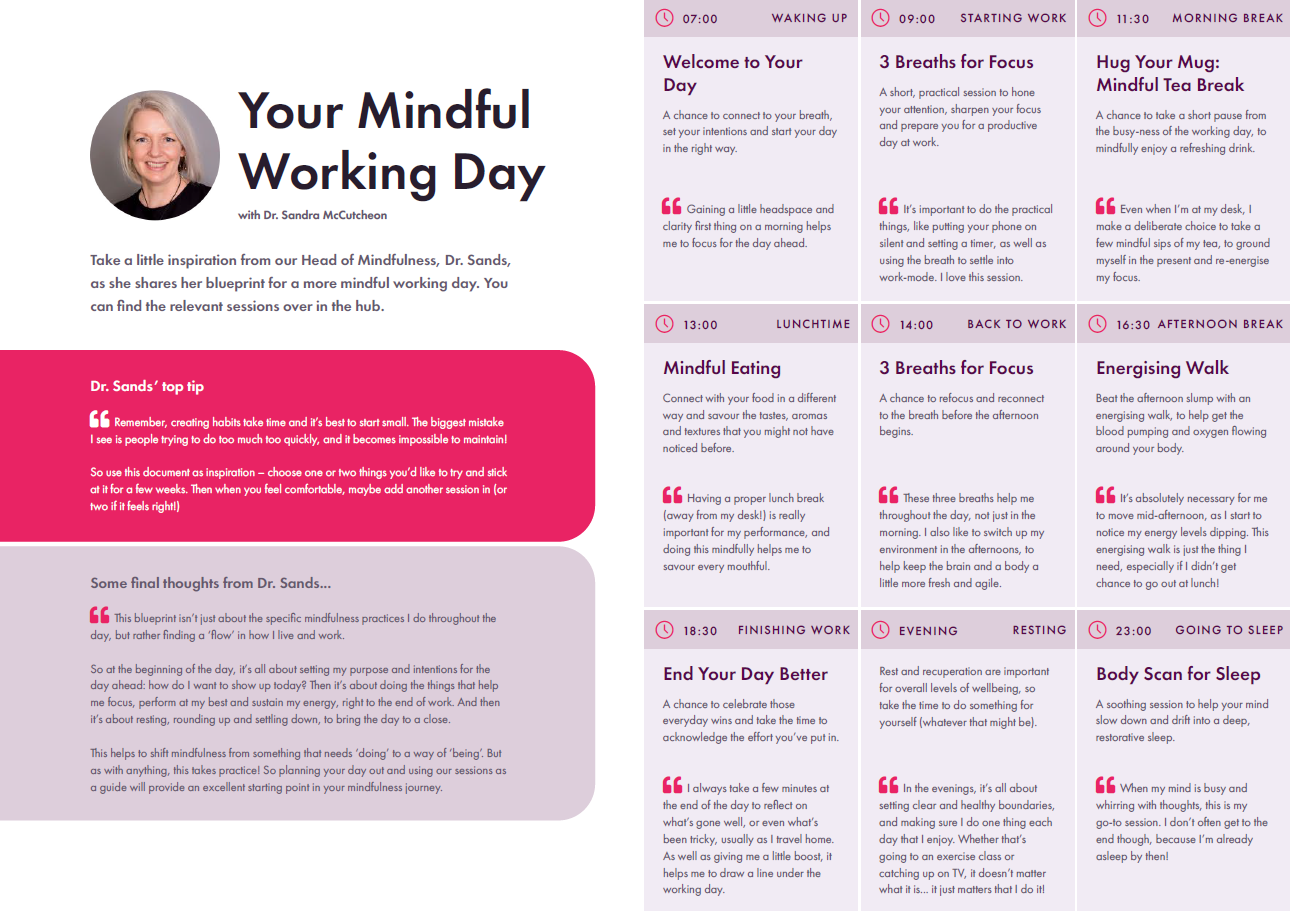Businesses with mindful teams are healthier, more engaged and higher performing, according to research from Harvard Business Review. So, as a HR professional or people manager, how can you encourage your people to practice mindfulness at work?
The ability to be present and mindful is gaining recognition as a vital skill in the modern working environment.
And while mindfulness was once associated only with protecting mental health, research is now showing that there are also performance-related benefits to mindfulness at work.
This has led to a greater understanding of the competitive advantage of mindful teams, with many companies — including Google, Apple and Nike — now taking steps to develop more mindful teams.
To help you do the same, we’ve created the HR Guide to Mindfulness at Work. Read on to discover:
What is mindfulness?
Put simply – the phrase ‘being mindful’ refers to being in the present moment.
Mindfulness is the ability to be aware of where we are and what we’re doing, without being reactive or overwhelmed by what’s going on around us.
When you’re lying on the beach, doing nothing but listening to the waves crash into the rocks, you’re being mindful. Or if you’re paying attention to your breathing before a presentation, that’s mindfulness at work.
Mindfulness also means not judging our thoughts and feelings – or believing we should think or feel a certain way about a situation.
Mindfulness is about self-awareness. It’s about knowing the detail of our moment-to-moment experience. I like to think of it as a kind of internal weather report.
When we practice mindfulness, we tune our thoughts into what we’re sensing in the present moment rather than going back over the past or imagining the future. Watch the video below to learn more about this.
Developing a mindful team, with people who are able to pay attention to the present moment, brings benefits to your business, like better engagement, improved decision-making and increased focus. Read this article for a deeper dive into the benefits of mindfulness at work.
6 Ways to be mindful at work
Your employees don’t need to meditate every day to experience the benefits of mindfulness at work.
Mindfulness can be built in around a day, no matter how busy it is, and we have six techniques to start you off.
Here are six simple ways to practice mindfulness at work:
- Focus on your breath
- Set mindful reminders
- Take a mindful break
- Actively listen
- Implement a mindful commute
- Become a single-tasker
Read on for an in-depth look at each of these mindfulness tips and tricks.
1. Focus on your breath
Focusing on your breath is an effective way to live in the present moment and it’s particularly useful when you start to feel stressed.
Stress often involves worrying about the future and reliving or editing events of the past. However, when you focus on your breath, you are guiding your attention back to the present moment.
Certain breathing techniques are known to help reduce stress and induce relaxation. So, focus on your inhalation and exhalation and you’ll feel yourself begin to relax. For help with this, follow this simple breathing exercise in the video below.
2. Set mindful reminders
The more you practice mindfulness, the more natural it will become. However, when you’re starting out on your mindfulness journey, you may have to remember to be mindful.
Even with the best intentions, it’s easy to forget to be mindful. When life gets busy, it’s common to focus on everything you must do and switch off from your thoughts and feelings.
Use the resource below to help plan out your reminders and learn how you can work mindfulness into your day. But remember, you don’t have to commit to completing all of those activities! Start with one or two and stick to it.
By using mindful reminders, you will create regular points in your day where you work on living in the present.
These reminders could be as simple as a phone notification every hour that reminds you to breath mndfully (like in the video above). By introducing them into your routine, you will help mindfulness will become a more natural part of your day.
3. Take a mindful break
Most people don’t think they have time in their diary for regular breaks, particularly if they want to stay productive.
However, a study by DeskTime found that the most productive employees were ones who took regular breaks – every hour or so.
So, why not try incorporating these regular breaks into you day? You might find they do wonders for your productivity – particularly in the afternoon when your brain starts to tire. In the Workplace Health Report: 2022, we found that the least energetic time of day for employees was 3:31pm.
During these breaks, take some mindful moments. These could involve taking a mindful walk, focusing on your breathing, completing a meditation or anything else that works for you.
4. Actively listen
Being mindful is sometimes as simple as really listening to what your co-workers are saying throughout the working day.
It’s easy to switch off when others are talking, particularly if you’re busy, stressed or tired. However, by really tuning in to what your co-workers are saying, you’ll learn to quiet the internal chatter in your head and create the space to really process what they’re trying to tell you.
As well as helping you be more mindful, active listening will help build rapport, strengthen your relationships at work and is even useful when discussing mental health in staff appraisals.
5. Implement a mindful commute
Your commute is a great time to mindfully unwind at the start and end of the day. This will reduce the chances of you worrying about work when you get home, which is vital to maintaining a healthy work/life balance.
So, utilise this time to switch off from work, and tune in to a mindful moment. Enjoy a mindful commute by:
- Noticing the smells, sounds and sights around you
- Focusing on your breath
- Turning off your phone and any other distractions
And if any thoughts or stresses about work issue arise, acknowledge them, and then try and let them go.
If you’re a remote worker, implement a mindful commute by going for a short walk at the start and end of each day. And if your commute is mainly spent in your car or on public transport, consider if you can build a mindful walk into that.
Even if it means walking a longer route or getting off the bus a few stops early, you’ll benefit from taking that time to regularly unwind and be mindful.
And if you’re lucky enough to be near nature, you’ll also be able to enjoy some of the mental health benefits of nature.
6. Become a single-tasker
Multi-tasking is a myth. It can make you feel more productive, but research shows it’s actually making you less productive.
Because when you multi-task, you’re not actually focusing on several task at once. Instead, you’re focusing on one task at once, but switching that focus so quickly between different tasks that none of them really get the attention they need.
So, to become a more mindful (and productive) person, become a single-tasker. By training yourself to come back to the present moment, and paying attention to one task at a time, you will become a more focussed and effective worker.
How to encourage mindfulness at work
As leading organisations like Google and Apple will tell you, bringing mindfulness to the workplace is a fantastic way to boost employee health and increase your competitive advantage.
Considering this, it’s no surprise that mindfulness is fast becoming an invaluable tool for people leaders to support their colleagues.
With that in mind, here are three ways to encourage mindfulness at work:
- Lead by example
- Start a conversation about mindfulness at work
- Create space for mindfulness at work
Let’s take a look at each in more detail below.
1. Encourage your leaders to set a mindful example
Increasing mindfulness at work starts from the top down. If your people don’t see your leaders practicing what they preach, they’re unlikely to practice it themselves.
So, encourage your leaders to set a mindful example, by:
- Sharing stories about how mindfulness helps them (or will help them if they are not already utilising it)
- Ensuring their teams see them take mindful breaks
- Incorporating mindfulness into all-hands meetings
By taking these simple steps, your leaders will give your people permission to incorporate mindfulness into their own working days too.
2. Start a conversation about mindfulness at work
Mindfulness is sometimes misunderstood because it’s often not spoken about. This means that when the topic of mindfulness comes up, many immediately think it’s fluffy, frightening or won’t work for them.
Remove this stigma by starting and maintaining conversations around mindfulness with your employees. This could involve:
- Sharing mindfulness resources on company channels – which Google found success doing
- Encouraging leaders to promote mindfulness during all-hands company meetings
- Introducing mindfulness training for your staff
As well as giving them permission to explore mindfulness themselves, maintaining a positive conversation around mindfulness will also help dispel some of the myths surrounding it.
In addition, encourage team members who practice mindfulness at work to share the techniques that they use. As well as helping demystify the topic, this may give other employees a good place to start with their mindfulness journey.
Take inspiration from this podcast to help bust those mindfulness myths and explain that the evidence shows it really does work.
3. Create space for mindfulness at work
In today’s hyper-paced working environments, it’s common for employees to prioritise work over wellbeing, even when encouraged not to.
So, to reduce the chances of mindfulness falling by the wayside, create space for your people to take mindful moments by:
- Scheduling in ten minutes at the start of each day for employees to focus on their intentions and goals
- Setting aside five minutes for mindfulness at the end of every meeting
- Scheduling in times for brain breaks
Unleash the power of mindfulness at work
Integrating mindfulness into your organisation can be challenging, but the companies that manage it are seeing a huge benefit.
As leaders and managers, by unleashing the power of mindfulness, you will develop a team that is more engaged, more productive and more able to adapt.
And by being fully present — and allowing your team to be fully present — you will reap the rewards on a personal and professional level.





